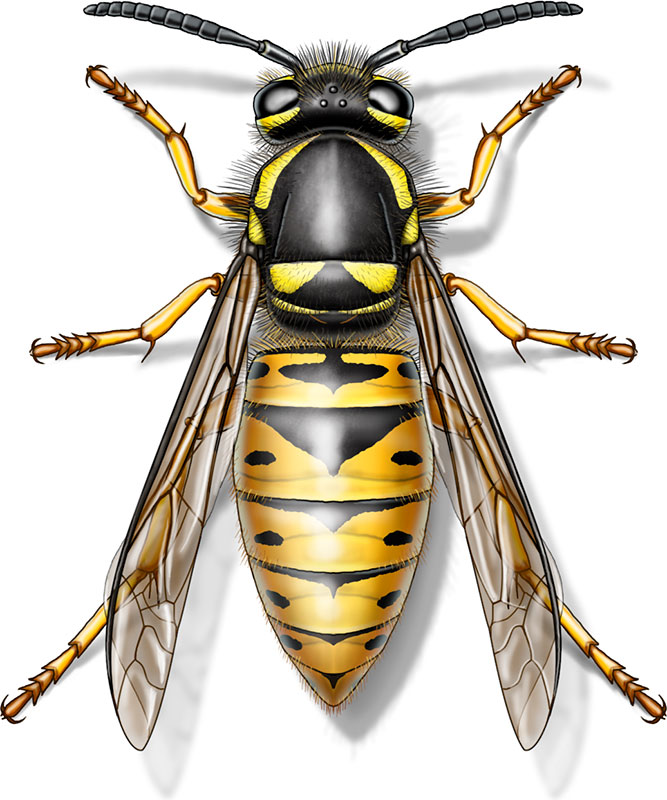Stinging Insect Control

Why DIY When You Can Eliminate the Problem Professionally and Affordably?
Effective and Thorough Removal
Comprehensive Solutions
Cost-Effective Approach
Understanding Seasonal Activity and Aggression of Stinging Insects
Spring and Summer: Nest Building and Growth
- Spring: During the spring months, queen wasps and hornets emerge from hibernation and begin building new nests. This is a critical time for early intervention, as nests are smaller and easier to manage.
- Activity: Moderate; focused on nest building and reproduction.
Fall: Peak Aggression and Colony Decline
- Fall: Wasps and hornets are most aggressive in the fall. As food sources dwindle, they become more territorial and protective of their nests.
- Aggression: High; wasps and hornets are more likely to sting if disturbed.
- Danger: Killing one or two wasps or hornets can release a pheromone that signals danger to the rest of the colony, triggering an aggressive response and increasing the risk of multiple stings.
Winter: Dormancy
- Winter: In colder climates, most wasps and hornets die off, with only the fertilized queens surviving the winter by hibernating in sheltered locations.
- Activity: Low; colonies die off except for hibernating queens.

Species Found in Massachusetts

Bald-Faced Hornet (Dolichovespula maculata)

Yellow Jacket (Vespula spp.)

Paper Wasp (Polistes spp.)
Bald-Faced Hornet
Bald-faced hornets are large, black-and-white wasps known for their aggressive nature. They build sizable, paper-like nests in trees, shrubs, or under eaves. Highly protective of their nests, these hornets can sting multiple times and are most active from late summer to early fall.Yellow Jacket
Yellow jackets are small, and yellow and black wasps are often mistaken for bees. They build nests in the ground, wall voids, or attics and are highly aggressive, especially in the fall. They can sting repeatedly and are known for their painful stings, often becoming more aggressive when their nest is disturbed.Paper Wasp
Paper wasps are slender, brownish wasps with yellow markings. They build small, open comb nests under eaves, attics, or trees. While less aggressive than other wasps, they will defend their nests if threatened and can deliver painful stings.European Hornet
European hornets are large, reddish-brown wasps with yellow stripes. They build nests in hollow trees, wall voids, and attics. These hornets are less aggressive than bald-faced hornets but will still defend their nests vigorously. Unlike most other wasps, European hornets are active both day and night.Cicada Killer
Cicada Killer wasps are large, solitary wasps known for their size and unique behavior. These wasps are named for their habit of hunting cicadas, which they paralyze and bring back to their burrows as food for their larvae. Despite their intimidating appearance, cicada killers are generally non-aggressive towards humans and rarely sting unless provoked. They typically emerge in mid to late summer. Their lifecycle is annual, with adult wasps emerging in the warmer months to mate and lay eggs. The larvae then develop over the winter and pupate in the spring, leading to the emergence of new adults the following summer.


Solitary and Ground Species: Typically Non-aggressive but Nuisance Pests
Solitary Wasps
Solitary wasps, such as mud daubers and cicada killers, live and operate alone rather than in colonies. They build individual nests in various locations, including ground, wood, or under eaves.
Stinging Behavior:
- Solitary wasps are typically non-aggressive and rarely sting humans unless directly handled or provoked.
- Their primary use of stingers is for hunting prey rather than for defense.
-
Ground Wasps
Ground wasps, including species like the great golden digger wasp and the eastern cicada killer, nest in burrows in the soil. These wasps are commonly seen flying low over the ground or entering and exiting their nest burrows.
Stinging Behavior:
- Ground wasps are generally non-aggressive towards humans.
- While they can sting, they mainly paralyze their prey, such as cicadas or other insects, to provide food for their larvae.
Carpenter Bees
Carpenter bees are large, solitary bees that resemble bumblebees but have a shiny, black abdomen. They bore into wood to create nesting sites, often causing structural damage.
Stinging Behavior:
- Carpenter bees are generally non-aggressive and rarely sting humans. Males cannot sting; females only sting if directly handled or threatened.
- Their primary concern is drilling into wood to create tunnels for laying eggs, which can make them a nuisance around wooden structures.
While solitary and ground wasps can sting, they are much less likely to do so compared to social wasps like yellow jackets and bald-faced hornets. Their stings are usually reserved for hunting rather than defending a nest, making them less of a threat to humans. However, their nesting habits can still make them a nuisance in residential property settings.
Home Guard Program

What Our Customers Say
Ready to take your pest control to the next level?
Request a free estimate for your home and experience the Ecologic Entomology difference: innovative pest management.
